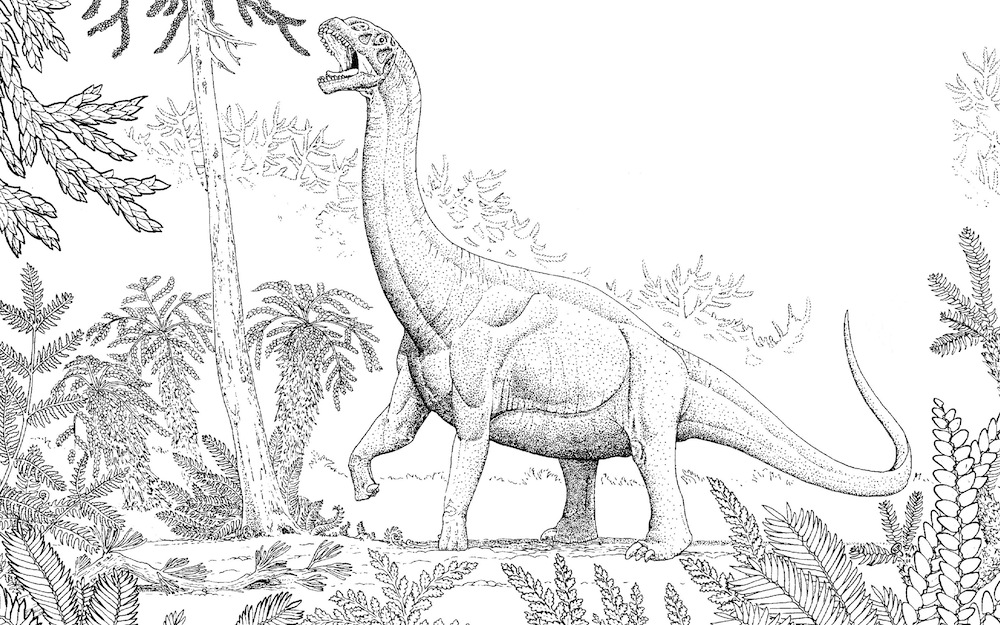Dinosaurs Migrated, Tooth Fossils Confirm

Gigantic plant-eating dinosaurs called sauropods took yearly jaunts to high ground to escape drought, new research suggests.
By analyzing fossilized dinosaur teeth, researchers determined that the dinosaurs migrated hundreds of miles from their home to find food and water during dry spells. This is the first direct evidence supporting the theory that certain types of dinosaurs migrated to avoid seasonal food slumps.
"Sauropods in western North America were living in an environment that was seasonally dry, that has a pronounced wet season and a pronounced dry season," said study researcher Henry Fricke of Colorado College. "If you have an animal that needs to eat a lot and drink a lot, it's going to have to move to access vegetation and to get water."
Tales dinosaur teeth tell
Every five to six months throughout a dinosaur's life, they would lose their teeth and grow new ones . The new growth contained elements that the dinosaurs took in from their food and water, and the elements differed by location.
The researchers focused on oxygen-18 isotopes (heavy atoms of the common element oxygen that have two extra, non-charged particles called neutrons) in the dinosaur teeth. The team found that the water and plants in lower-altitude regions of North America contained relatively high levels of oxygen-18. It was already known that highlands generally have lower levels of oxygen-18 in relation to lighter oxygen isotopes.
Next, the scientists measured the oxygen isotopes in sauropod (specifically the genus Camarasaurus) teeth found in the low-altitude Dinosaur National Monument in Utah and Thermopolis fossil bed in Wyoming. These formations were laid down between about 150 million and 100 million years ago.
Sign up for the Live Science daily newsletter now
Get the world’s most fascinating discoveries delivered straight to your inbox.
Because the dinosaurs' isotope levels were lower than the levels found in the basin, the results indicated the dinosaurs had left the basin at some recent point and then returned.
"We attribute that to those dinosaurs having migrated out of the basin and drinking waters from somewhere else," Fricke said. The dinosaurs probably traveled more than 350 miles (600 kilometers) to find food and water in the highlands. "They appear to show isotopes from the highlands, but they were found in the basin."
Seasonal movements
It probably takes a few weeks for the isotopes to become part of the dinosaur's tooth enamel, so it's possible the dinosaurs with low oxygen-18 levels had just gotten back from their time in the highlands when they died. Not all of the dinosaurs showed the same isotope levels, since they probably died at different times of the year, including some that died just before leaving for their upland trek (and would have had the isotope signature of the lowlands).
Because of the dry seasons, the basin probably wasn't able to produce enough vegetation to support these gigantic plant-eating dinosaurs year-round.
This seasonal migration to the cooler, wetter highlands had been suggested before, but no solid evidence had been found supporting the theory. This is the first solid evidence backing up a claim that dinosaurs migrated, according to the study researchers.
Areas that were highlands haven't been preserved by nature, so no dinosaur fossils have been found there. "That's one of the biggest challenges in paleontology. Most sediments get deposited in the basins and the highlands erode away," Fricke said. "We don't have a good record of anything really, even mammals, in high-altitude environments."
The study was published today (Oct 26) in the journal Nature.
You can follow LiveScience staff writer Jennifer Welsh on Twitter @microbelover. Follow LiveScience for the latest in science news and discoveries on Twitter @livescience and on Facebook.
Jennifer Welsh is a Connecticut-based science writer and editor and a regular contributor to Live Science. She also has several years of bench work in cancer research and anti-viral drug discovery under her belt. She has previously written for Science News, VerywellHealth, The Scientist, Discover Magazine, WIRED Science, and Business Insider.










